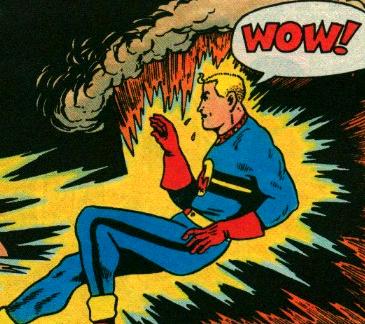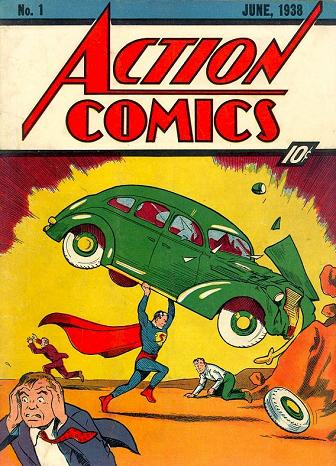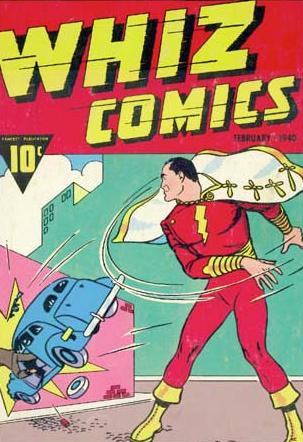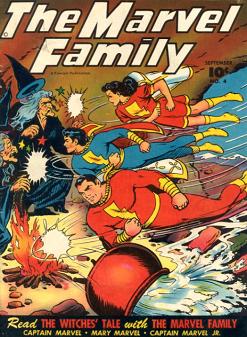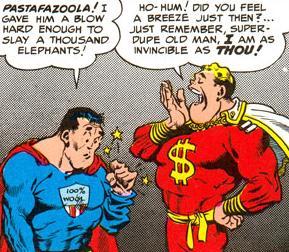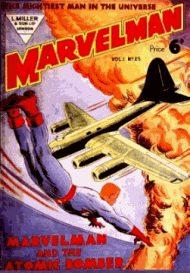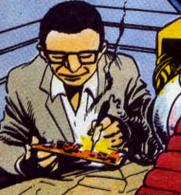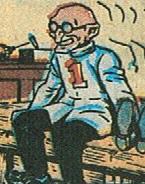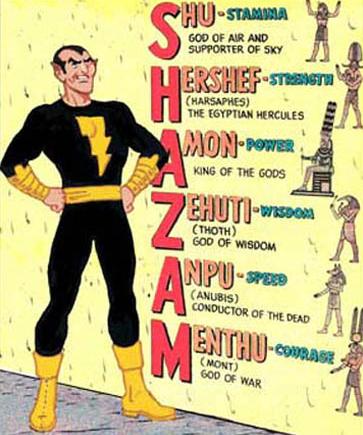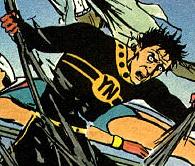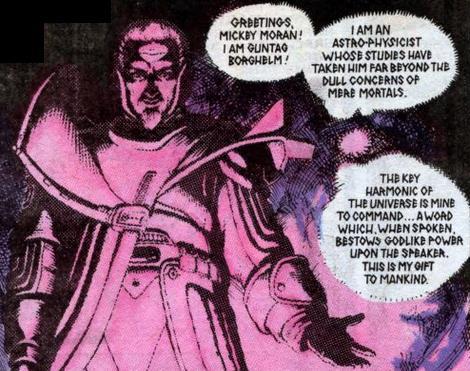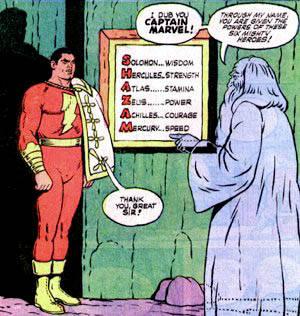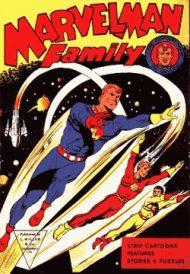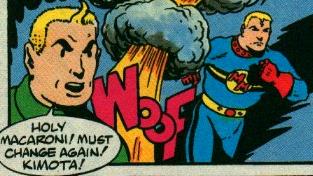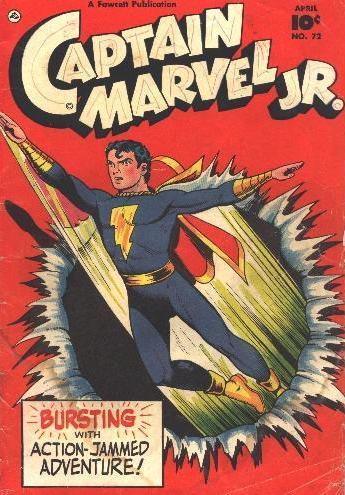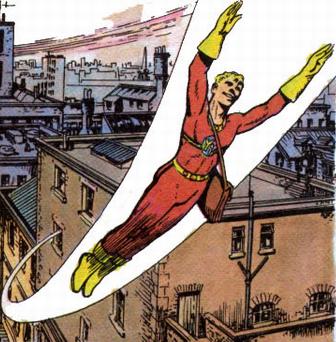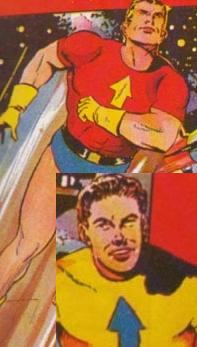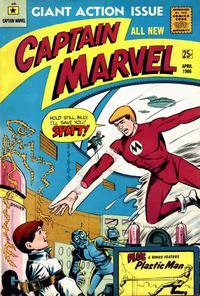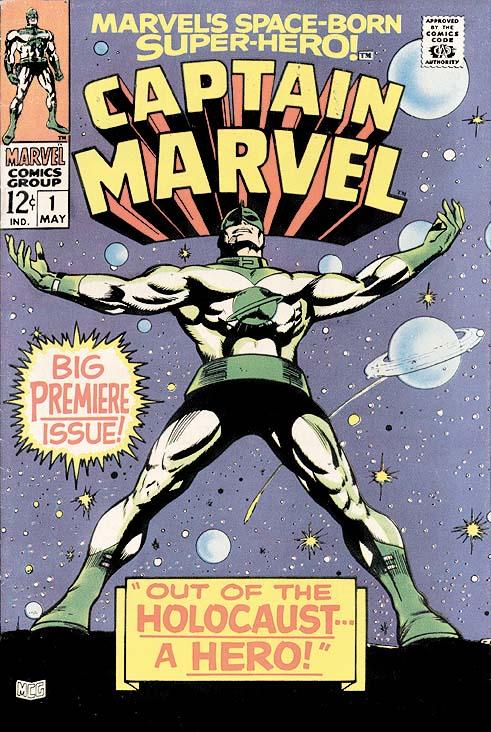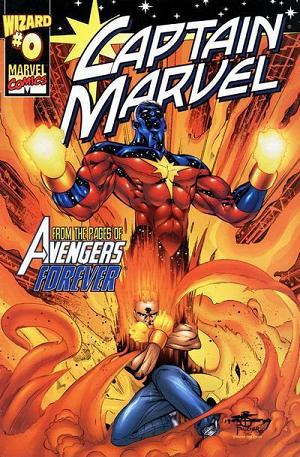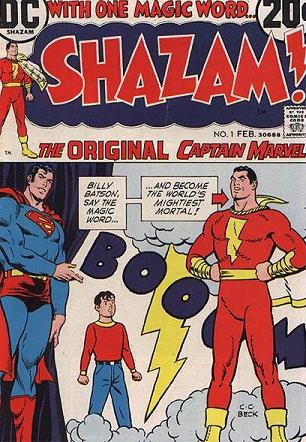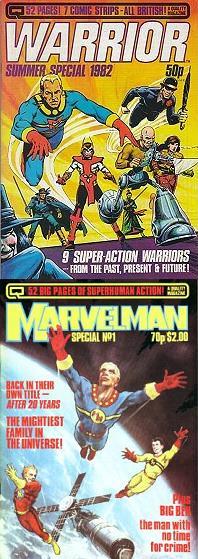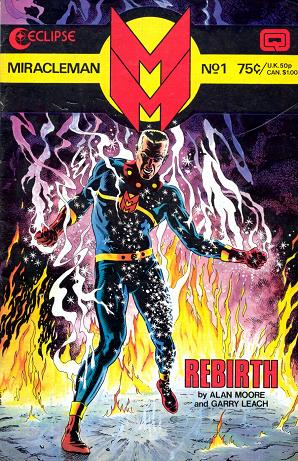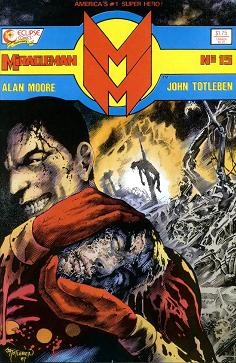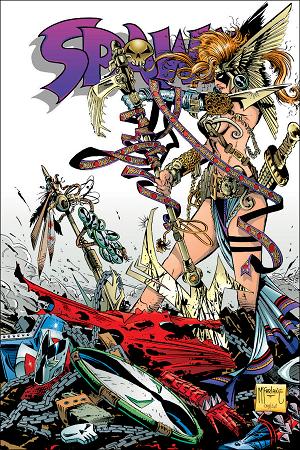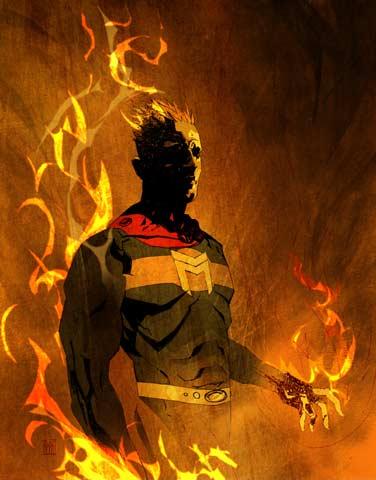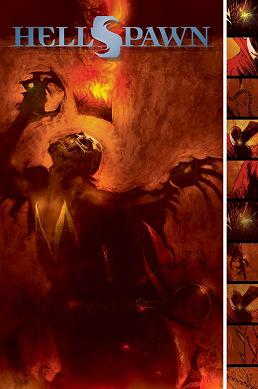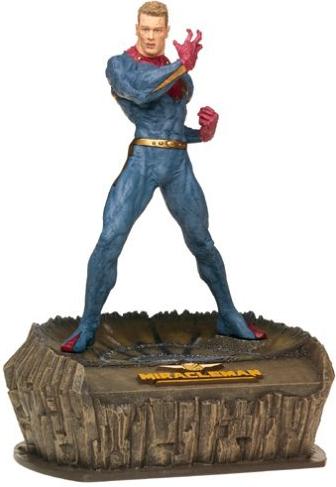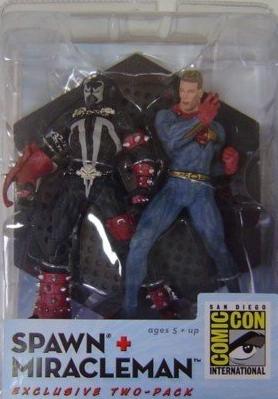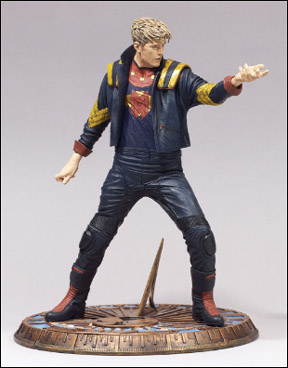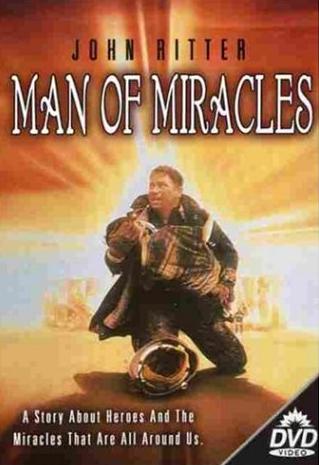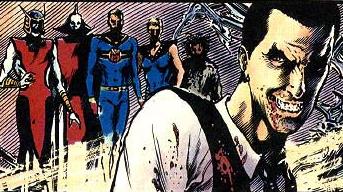Miracleman was originally known as "Marvelman", and can be considered the illegitimate grandson of Superman himself. In 1938 Superman first saw publication in Action Comics #1. The creation of two young Jewish men named Jerome Siegel and Joseph Shuster, Superman was more than the ironic reclamation of "The ▄bermensch". In fact, the character changed comic books (and pop culture) forever, as the first ever "Superhero". As any trip to the Cineplex will tell you, Superman wasn't the last. He inspired corollaries and partners, pastiches and rip-offs. The most famous of the similar superheroes was a character named "Captain Marvel" (originally "Captain Thunder" as created by C.C. Beck and Bill Parker),
He also brought along his fellow Fawcett superheroes, such as his sister Mary Bromfeld, aka Mary Marvel, and their good friend Freddy Freeman, aka Captain Marvel Junior. While Mary shared her brother's use of the magic word "Shazam!", Freddy's magic word was "Captain Marvel!" which made it pretty much impossible for Freddy to introduce himself without getting struck by lightning.
The "Marvel Family" was popular enough with kids to see a fan and critically acclaimed 12 part serial called Adventures of Captain Marvel (1941) from Republic Pictures (still today considered one of the best serials of all time) and publication of their comic book adventures not just in the USA but in other countries as well, most notably those UK black and white weeklies. More on that later. Beck and Parker were said to have based the good-natured senior hero after Fred MacMurray, whose smiling face was recognized and respected at that time. However, it's the man whom Captain Marvel, or rather, Captain Marvel Junior, inspired that takes the proverbial cake. Legend has it that a young fan of Captain Marvel Junior brought his favorite comic book in with him to the barber shop one day and insisted that the scissor-man make his hair look just like Freddy Feeman's. The barber did, and that kid's hair has become synonymous with his fame ever since. While the name didn't mean much at the time, we know him today as Elvis Presley. While Superman was "The Man of Steel", Captain Marvel was "The World's Mightiest Mortal". Superman was "Big Blue", Captain Marvel was "The Big Red Cheese". Many readers found this redundant, and chose either one or the other. National Periodical Publications (now DC Comics) saw the similarities to their own character as well, not to mention the fact that the stories of the Marvel Family had begun to outsell those of Superman and his friends. Naturally, in 1941 National Periodical Publications sued Fawcett Comics for Copyright infringement, alleging that Captain Marvel was far too close a character to Superman for comfort.
The final verdict of the Fawcett/ DC case was found in favor of Superman's publisher. To their credit, Fawcett saw the writing on the wall and settled the suit out of court, agreeing to stop publishing Captain Marvel (whose sales were declining by 1954 anyway). One by one the Captain Marvel comics ended publication, with the final Golden Age appearance being The Marvel Family #89, January 1954 (actually predating the publication of Seduction of the Innocent by several months). Superman had won, but he found himself in a very different comic book world. Captain Marvel was seemingly no more and Superhero Comics had declined considerably. In their place were Funny Animals, Westerns and Romances. Only Batman and Superman continued to stagger along until slowly the Silver Age brought back their friends (in various different formats). Still, for a short time it appeared that the Man of Tomorrow might well have become a thing of the Past. Sales were just strong enough to ward off the Kryptonite effect. But this isn't a history of Comics in General. With the set up behind us, let's get back to the lecture at hand, namely, Miracleman. Meanwhile, back across the Pond, the UK publishing firm L. Miller and Son discovered that with Captain Marvel gone, so was their supply of US Reprints, courtesy of Fawcett. Already Captain Marvel was a graphic symbol of litigation, so simply continuing this run (with new writers and artists) was not an option. However, neither was simply scrapping the comic altogether, as English Children had come to expect the adventures of the Marvel Family week by week. Luckily they had the time it took to run out of reprints to figure out what to do. What DID Len Miller do? Elementary, my dear Batson: a compromise, of course!
Ironically, although the powers, history and affiliations were 100% Captain Marvel inspired, it's interesting to note that Marvelman actually went full circle and much more closely resembled Superman than his direct Fawcett parent. Mickey Moran's Alter Ego wore a blue suit like Superman's with his initials emblazoned in red in the same place on the chest. He even wore bright red boots, though the cape worn by both the Captain and the Man was conspicuously absent on this New Marvel. Incidentally, unlike Billy Batson, Mickey Moran didn't report for a Radio Station, he reported for a newspaper. That newspaper's name: The Daily Bugle. Yes, this did predate Spider-Man and his Marvelous employer by a good eight years. The final Fawcett-Inclusive issue of the strip was program 24 and was renamed Captain Marvel: The Marvelman. With issue 25, published on February 23, 1954, just one month after the final USA appearance of the Fawcett Marvels, the L. Miller and Son title became simply Marvelman. After that, Captain Marvel Junior became Young Marvelman with issue 24. The group (now known as "The Marvelman Family") continued their predecessors' successes for some time and, in turn, were also reprinted in foreign countries such as Italy and Brazil as well (not the USA, of course... at least, not yet). The titles continued as weeklies for the next Three Hundred Forty-Six weeks, and as monthlies for the next Thirty-Six months beyond that. Interestingly enough, the one title that didn't continue to be a smash-hit was the one actually titled Marvelman Family which ended a thirty issue run in November of 1959. The other two Marvelman titles continued their impressive run until their cancellation in 1963. American comics were, by this time, finding new successes in the USA, and soon, in England as well and in four colors, not just black and white. Len Miller cut costs by ceasing newly commissioned stories and ironically turned the comic spawned from a reprint back into a reprint (this time, of itself). Most of the Marvelman and Family stories between 1959 and 1963 were, in fact, not first-time publications. Ultimately the line folded and the physical assets relating to L. Miller and Sons' comic publications (namely, the printing plates) were sold to Alan Class, Ltd. The Marvelman Family simply couldn't quite compete with their American counterparts, even with home field advantage. It seems that Fawcett had been right about the character losing the public's interest, though they were nine years and an ocean off the mark on their prediction.
So that's the end of the story for Marvelman? Not even close true believers. Let's flash back to the States again where the Silver Age of comics was, by this time, in full bloom. Green Lantern, The Flash, and more had received Marvelman-esque makeovers for the 50's and 60's. Comics were on the rise again, and a competitor to both Fawcett and DC known as Timely had adopted its flagship title as its corporate name, thus becoming Marvel Comics. (Similarly, National Periodical Publications was nicknamed and later, officially named DC because of its famed title Detective Comics). Having a company actually named "Marvel" created an interesting situation, especially in the absence of any active character named Captain Marvel.
This was lucky for Marvel Comics, of course, if they even noticed. Legally holding the name "Marvel", the "BULLPEN's" own Stan Lee and collaborator Gene Colan believed they should naturally have a character named "Captain Marvel". The Alien Military officer they created and named Captain Mar-Vell fit the bill quite nicely upon his debut in December of 1967's Marvel Super-Heroes # 12. This Captain Marvel (followed by four(!) others to date at Marvel Comics), was never as recognized or as successful as the original, but did have one special power that Billy Batson's "Shazam" never dreamed of: A copyright on the name "Captain Marvel". Throughout the many incarnations of the Marvel Captain Marvel it is interesting to note that the best known actually much more closely resembled the original hero! Note his red form-fitting costume, yellow Star Insignia (instead of the original's lightning Bolt) and even his sharing of an identity with a young boy who could summon him at will. This time the boy was long-time Marvel supporting character Rick Jones who also managed to turn into The Hulk a few times! Here's where a convoluted story becomes positively bizarre. Fawcett still existed during the Silver Age and beyond but couldn't legally publish Captain Marvel stories because of the settlement with DC Comics from over a decade before. They therefore licensed that intellectual property to another company for publication. That company was, if you can believe this, DC Comics! However, DC had shot themselves in the proverbial foot over publication of this character with their own copyright infringement lawsuit from years past. Marvel now owned the copyright to the name "Captain Marvel" (and were fiercely litigious for years to come on any similar name). It took some time, but in February of 1973, twenty years after the character's last appearance and ten since the folding of Marvelman, Captain Marvel returned to the newsstands.
The adoption of the Marvel Family added yet another "Universe" to the DC "Multiverse". DC carried on with Captain Marvel, eventually coming to own the character and his counterparts outright in 1980 after Fawcett's decline and piecemeal sale to CBS and Ballantine Books. While never receiving quite the fan-base he once did, Captain Marvel did inspire two television series, the live action Shazam! and the animated Kid Superpower Hour with Shazam! Both of these used Captain Marvel as the name of the character, but necessarily had to avoid the use of the word "Marvel" in the title. These helped in the unfortunate confusion in Pop Culture of the name "Shazam" being linked with the character, not the magic word or the wizard who imparted power upon him. Even today DC's Captain Marvel comics don't feature his name in the title and the licensed merchandise (including action figures) carry the trademark of "Shazam". Like Freddy Freeman before them, it almost appears that DC is forbidden from using the name of their own hero. Back across the Atlantic we hop to an England who has embraced comics anew. Marvel Comics had launched the imprint Marvel UK there and anthology strips like 2000 AD featuring Judge Dredd had done very well. Enter the incomparable Alan Moore who was slowly but surely making a name for himself with his more mature writing for funnybooks like Marvel UK's Captain Britain and more. Dez Skinn, an editor working for Quality Communications, brought in Alan Moore and other creators to launch the new anthology title known as Warrior.
Chosen as the flagship character for Warrior was none other than Marvelman himself, who had been off the radar for twenty years. Rights to the character were divided between Skinn, Moore, Quality, and the Marvelman artists Garry Leach and Alan Davis. You may notice that Mick Anglo, Alan Class and Len Miller don't figure in to this division of property. Warrior continued as a weekly rival to 2000 AD and featured not only Marvelman but the priest "Father Shandor", the cyborg "Axel Pressbutton" and, of course, "V For Vendetta" (whose exploits were later completed in the pages of DC Comics). Moore's take on Marvelman was no longer that of a young and innocent boy whose use of magic transformed him into an ▄bermensch. No, just as comic books had grown up, so had "Michael Moran" in real time. He was now twenty years older and had forgotten all about his heroic past. However when a terrorist attack at a nuclear power plant is covered by Michael Moran for the Daily Bugle the confusion leads him to almost accidentally read the word "atomic" backwards. "Kimota!" being said, Marvelman lives again. The resulting stories were a deconstruction of the superhero (a trademark of Moore's seen also in Batman: The Killing Joke and Watchmen amongst others). Marvelman wasn't a boy scout, nor did his stories always end happily. In fact Moore's tales ultimately called into question what effect the appearance of real godlike humans might have on the population in general. Things went along swimmingly until Quality published a spin-off called Marvelman Special. The name "Marvel" was now a trademark of Marvel Comics, and while the character certainly could exist, a magazine with such a title legally could not, at least not according to the Legal Eagles at the House of Ideas. Further complicating issues was the falling out Davis and Moore had over an unrelated disagreement over Stateside Captain Britain reprints. Marvelman's final Warrior appearance came in 1985's Warrior # 21. When it came time to (again, quite ironically) publish reprints of Marvelman's English adventures in the United States, more problems arose. Marvel wouldn't allow any company but Marvel to produce a comic book with the word Marvel in the title. Nor would Marvel agree to licensing the character due to the strip's deconstruction of their bread and butter (namely: Superheroes). DC, naturally, wouldn't touch it either, although the thought of Captain Marvel introducing Marvelman on the cover of Kimota! #1 certainly conjures up some great imaginary images.
Regardless of the past history, Miracleman # 1 appeared in 1985 with an August cover date (mere months after the final Warrior appearance). Eclipse reprinted the Warrior stories in the first several issues of Miracleman, replacing (almost) every appearance of the word "Marvel" with "Miracle". After the reprint run had ended Alan Moore returned (without Davis, who signed away his share of the rights to Leach) to complete his take on the hero. Already greatly praised in the USA by this time (thanks, in part, to his revitalization of Swamp Thing not to mention the Miracleman Reprints), Moore's new run (with artists John Totleben, Chuck Beckum and Rick Veitch) took the bright and childlike character into a much darker place even than he had during the Warrior run. Miracleman wasn't alone in his return. Although Young Miracleman is seen only in flashback, the amazing "Miraclewoman" soon upped the storytelling ante, and brought the series to an even stranger place. Most frighteningly, Kid Miracleman had grown up to become a super-powered evil maniac whose final battle with Miracleman (in the much sought-after Miracleman # 15) canonically inspired legends, stories and even religions surrounding the godlike Miracleman and the demonic "Bates". The issue is shockingly violent, but every bit as well written (by Moore) as it is drawn (by Totleben). It's not easy to find at an affordable price. A good quality copy will run you in excess of seventy dollars on Ebay, whereas the entire Eclipse run usually goes for between four and seven hundred dollars. I assure you, however... it's worth every penny. Moore completed his tale in issue 16 (during which ideal human creates the Platonic World) and turned over the book (as well as his share in the character) to his friend Neil Gaiman, whose surreal take on Miracleman is only matched by his incredible run on DC Comics/ Vertigo's The Sandman. As both series ran concurrently, many of the strange, otherworldly, science fiction and religious themes found in Sandman permeated Miracleman even more than such things affected Moore's run. Unfortunately, as respected and critically acclaimed as Miracleman was, this didn't always translate into popular sales. Eclipse Comics went bankrupt in 1994, leaving Gaiman only half-way through his second chapter of a three-part vision. The multi-issue arcs began with "The Golden Age" and continued into "The Silver Age", during which the series was forced to end. "The Dark Age" never saw the light of day. The final issue to see print was number 24, with 25 written, but unpublished. Well, we don't know yet. There are more chefs in the stew. Forgetting the battle between Superman and Captain Marvel, it can be stated that (pastiche or not) Marvelman was an original and copyrighted character now neither the property of Fawcett or DC (this could have been debated at the time, but probably not now). Creator rights were unknown in 1954, unfortunately, but Mick Anglo is still alive and claims ownership of his brainchild. However, legally the character was the property of the publishing firm L. Miller and Sons, not Anglo. L. Miller and Sons sold their comic book assets to Alan Class, Ltd., which leaves us with how the rights to the character fell into the hands of Dez Skinn, who divided the character up between himself and his partners. Therein lies the problem. In the early 1980s few remembered Marvelman outside of Nostalgia. Therefore, Dez Skinn figured he could simply assume ownership of the character, and that no one would care. He would probably have been right until he started making money from this character, public domain or not. Skinn never purchased the rights to Marvelman from Miller, Class or Anglo, however he did enter into a deal to pay Anglo for any reprinting of the old works. Those claiming ownership of the character assumed that a much deeper and more legal deal had been struck with... well, someone.
Gaiman successfully sued Todd McFarlane in 2002 and won an apparently sizeable amount of money in this suit. It has been argued by McFarlane supporters that the entire suit and disagreement is baseless as "Medieval Spawn", is really just "Spawn" in armor (he is referred to in the story only as "Spawn"), and that Angela is nothing but Spawn's exact opposite. No such supporting offer seems to successfully be made for Cogliostro. If I might editorialize for a bit here, McFarlane has always purported to be a champion of "Creator Rights" (after all, wasn't this the main driving force behind the "X-odus" and the creation of Image Comics?). Therefore, why should Gaiman be considered merely a worker for hire? Let's grant for one moment that the argument behind Medieval Spawn is accurate. Angela may well be Spawn's inversion, but she wasn't created by Todd McFarlane alone. Neither was Cogliostro, who has since become a major part of Spawn's story. Both characters required imagination, development and intelligence... in other words: Creativity. But back to Medieval Spawn. Let's look at Spawn himself. In essence, Spawn is a successful amalgam of Spider-Man and Batman, with enough supernatural elements thrown in to be "edgy". In McFarlane's early sketches, Spawn even sported a blue, Batman-like cape. How much different is that than putting armor on a new character based on Spawn? At the very least, Gaiman is the Co-Creator of these characters and deserves recompense as such, under the very rules by which Image was founded.
To (hopefully) clear those rights up past, present and future, Gaiman (himself a board-member of the Comic Book Legal Defense Fund) founded Marvels and Miracles, LLC. funded, in part, by the legal win over McFarlane. Amazingly, another great deal of funding came from the proceeds from Gaiman's own 1602, which he wrote for Marvel Comics.
The saga continues however, and Todd McFarlane is not saying Die just yet. In 2003 (after the lawsuit had been won by Gaiman), McFarlane Toys released an "Extremely Limited Edition Cold-Cast Resin" Statue of Miracleman, seemingly based on the cover to Miracleman #1, though differences are notable. I have one right here with me, by the way. On the underside of the box is the fine print that reads: "Miracleman is a trademark of Todd McFarlane Productions, Inc. The Miracleman action figure is (copyright) 2003 Todd McFarlane Production [sic]." That same year a promotional action figure was released only at the San Diego Comic Con of Miracleman (packaged with a Spawn Action Figure) from the same molding (and carrying the same fine print). The game of "Let's Piss Neil Off" continues at the house that Todd built. McFarlane has officially had the part of Cogliostro written out of (or "retconned" out of) the Spawn history. After all, McFarlane was also sued by Hockey Player Tony Twist because McFarlane named a mobster character after him without permission. That suit was equally as successful and McFarlane Productions filed for bankruptcy. Royalties-Schmoialties!
Coincidence? No!!! Take a look at the picture of Todd McFarlane's "Creation" Man of Miracles, and there can be little question in anyone's mind... right on down to the Miracleman "MM" symbol on the guy's chest. Of course in this particular image of the character's appearance in Spawn # 150 (one that has already inspired a new statue and action figure) he's wearing a jacket and pants, which is every bit as unique as the extra bass note Rob Van Winkle added to "Under Pressure" to make it "Ice Ice Baby". However, if you're swayed by this, let's take one more good look at Man of Miracles as drawn by Todd McFarlane himself from the Image 10th Anniversary Hardcover book. He's as Original as New Coke... and I wish Todd the same success with this character as New Coke received. Interestingly enough, I did an image search for "Man of Miracles" when researching this article, and found a simply fascinating (or should I say, marvelous) DVD cover for a John Ritter flick of that name. In the film Ritter plays a firefighter, however, looking at the cover, his fireman's jacket bears a striking resemblance to that of that darlin', sportin', smilin' Man of Miracles. Looks to me as if Todd took Miracleman, threw him in the jacket from that DVD cover and borrowed the name as well. And the saga goes on. No one knows the REAL owner of Miracleman (except those purporting to BE that owner), and it's been said (so often that some people actually believe it) that Miracleman is in the Public Domain. If that's so, then Woe to Todd-o, who did all this for nothing! For my tuppence... I certainly HOPE that Miracleman is in the public domain... if such a thing were proven to be true, watch this space for a new feature I'll be calling "The World's Greatest Critic Presents: The Michael Moran Show!" But to recap, Dez Skinn alternately claims partial ownership of the character or claims that the character should revert back to its original creators. This is in accordance with an alleged document signed by himself and representatives of Eclipse. However, whether by "original creators" he means, Moore, Davis, Leach and Skinn, or Siegel, Schuster, Beck and Parker, or even just Mick Anglo, we're just not clear on. For Mick Anglo's part, he claims that he is the rightful owner of Marvelman/ Miracleman, and has always been. All the series creators (most notably Alan Davis) claim ownership of their own work on the character. This doesn't seem to be a disputed claim. However, it's worth noting that Alan Moore, the man responsible for the character's success, revitalization and restructuring, is making no claim to ownership at all, having benevolently ceded his percentage of the character to Gaiman.
Neil Gaiman appears to want full ownership, but doesn't claim it without a legal decision affirming this. Todd McFarlane clearly believes he owns some or all of Miracleman, and seems to be claiming this high and low, to the point of virtually daring Neil to sue him again over "Man of Miracles".
But if the character just happens to be in the public domain, could DC Comics sue to obtain ownership of Miracleman, due to his similarities to Captain Marvel (a character they legally now own)? They did it TO Captain Marvel, can they do it FOR Captain Marvel? And if so, can the same be done for the Ultraverse's Prime character, who is a 13 year old boy who can turn into a Superhero at will? Not that they would, but... could they? Which brings up another question. Marvel technically (and depending on British Law) could own the name Miracleman, if not the name Marvelman for the very Moore/ Davis created character (itself a version of Marvelman). What's more, Marvel Comics now owns the Ultraverse, and, in turn, Prime. The legal entanglements of Prime would pale in contrast to those of Miracleman, but there is the hint that the creators of Prime (Bob Jacob, Gerard Jones and Len Strazewski) would require some form of royalties. So, could Marvel make some legal claim on the character of Marvelman and the uniqueness of these powers? After all, they now legally own two characters who are boys that transform into Adult Superheroes, as well as the rights to the name "Marvel" and (potentially) "Miracleman". This article is sure to grow, along with the other thirty billion Miracleman/ Marvelman internet threads. To be sure Marvelman/ Miracleman is a character born of litigation and has become the most litigious character in the history of Comic Books. For a character created in 1954 based on a character created in 1939 inspired by a character created in 1938, it's amazing to note that the litigation isn't over yet as of 2006. The only way this could get even more litigious is if I'm individually sued by everyone mentioned on this page and forced to take it down. Then again, I could always do what Eclipse did and replace the names with similar names. I'm thinking I'll take a page from Miracleman #2 and rename it "MACKERELMAN" as per Moore's suggestion. After all, as Moore said, "... he isn't really called MIRACLEMAN at all."
|
|
|
Before somebody copyrights it and I have to change the name! Or Click HERE for the Reviews Page...
|
| What's New? | Alphabetical Listing of Reviews! | SearchThisSite: | Advertise With Us! | About... | Lynx Links: | F*A*Q |
|---|---|---|---|---|---|---|
